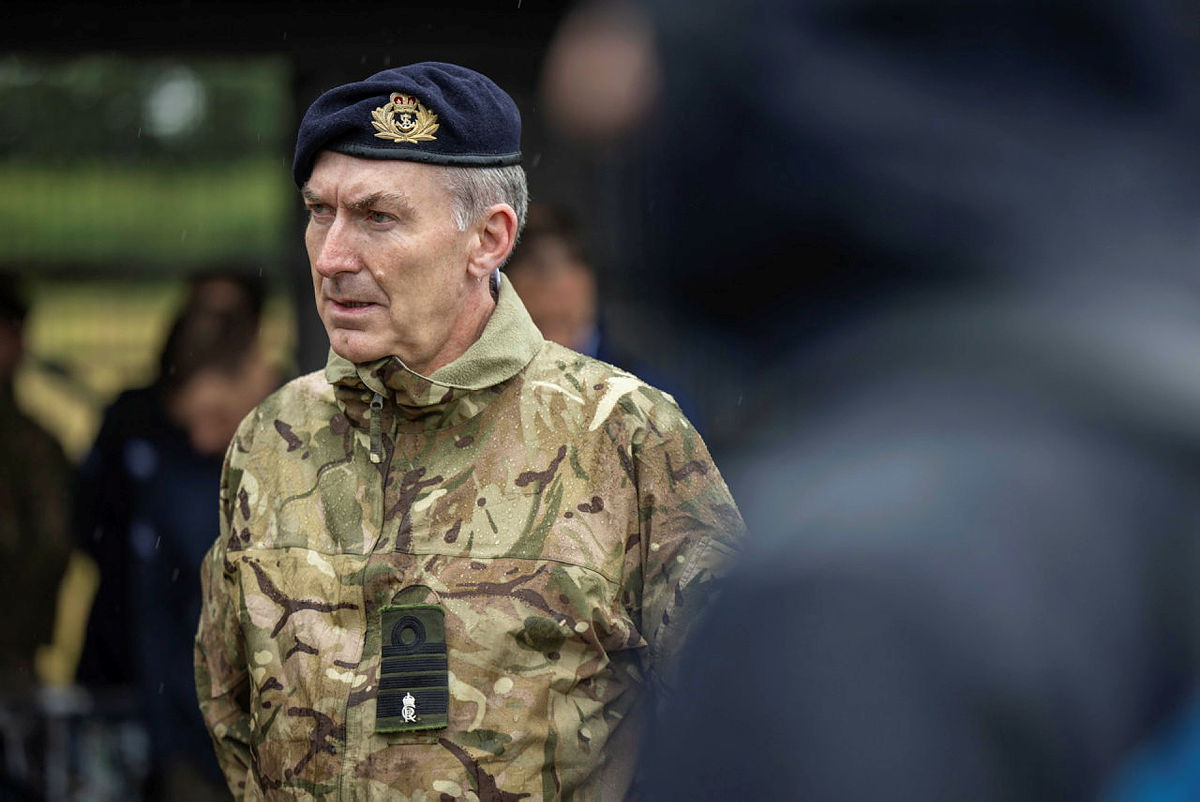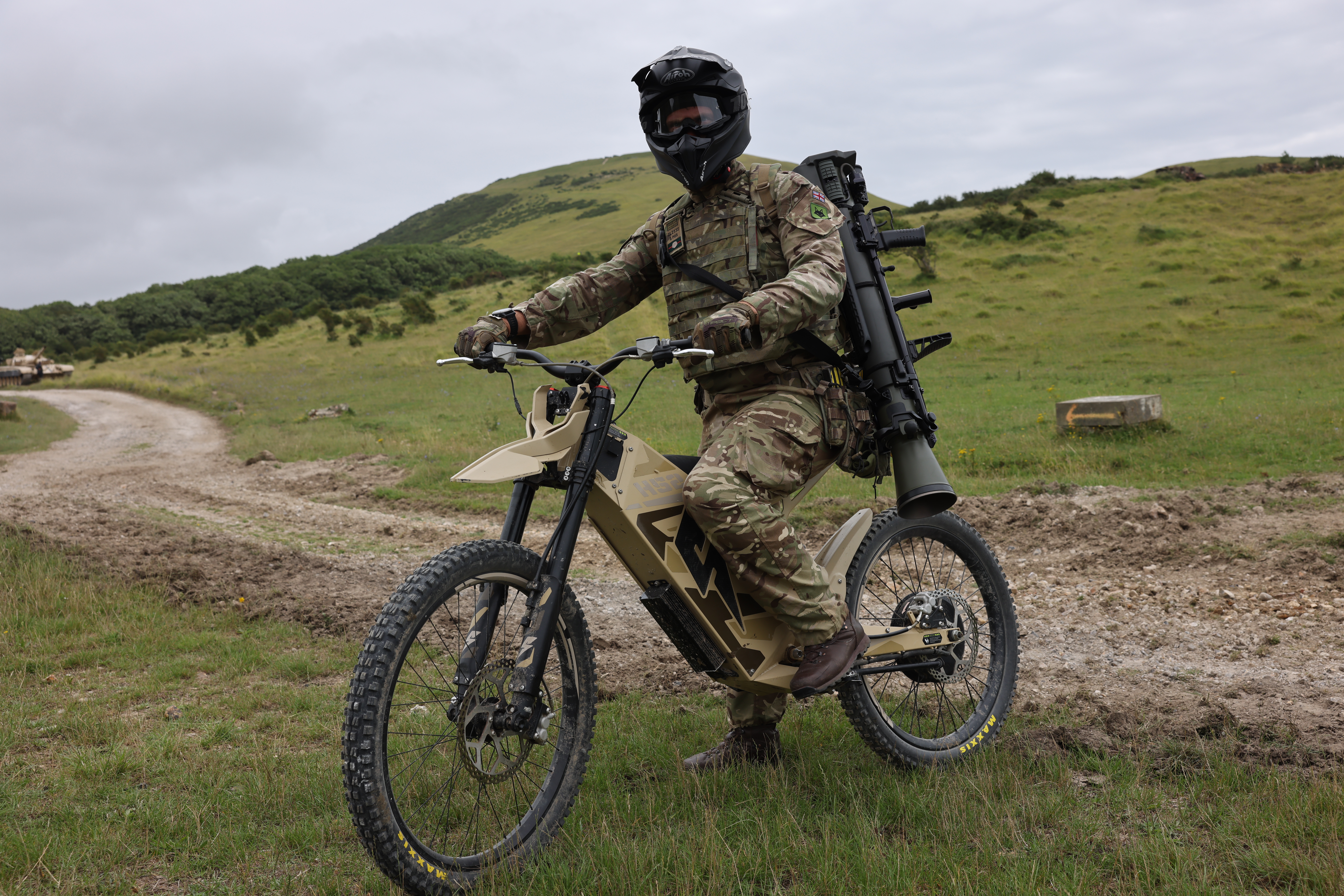Russian military equipment captured in Ukraine is being analyzed in the United Kingdom to help develop new weapons and tactics, the U.K. Ministry of Defense has confirmed. Russian armored vehicles are a particular focus of study, while new concepts developed in response to the war in Ukraine include a high-mobility vehicle armed with Brimstone anti-armor missiles, as well as infantry riding into battle on e-bikes while carrying recoilless rifles.

These new developments came to light during an event at the British Army’s Wellington Barracks in central London, attended by Admiral Sir Tony Radakin, the Chief of the Defense Staff, as well as Ben Wallace, the outgoing Secretary of State for Defense. The defense officials were talking to the media ahead of the release today of the latest Defense Command Paper, which sets out future plans for the U.K. Armed Forces.
That the United Kingdom is conducting so-called foreign materiel exploitation or FME, programs using Russian equipment captured in Ukraine is not surprising, considering the various intelligence windfalls that we know have already fallen into U.S. hands, for example. But U.K. defense officials had not previously disclosed details of specific FME programs benefiting from such captures.

Admiral Radakin told reporters: “It’s really important because we’re in a club of nations that when we get hold of Russian kit or other nations’ kit that might be a danger to us in the future, we share that knowledge.”
Clearly, the results of FME activities in the United Kingdom, the United States, as well as in Ukraine, and other allied nations are already being shared to help develop better counters to Russian threat systems.

Admiral Radakin also referred specifically to FME involving Russian military vehicles.
“We also have the scientists that unpick the detail that another nation might have to a really forensic level, and that helps us to understand: how does their equipment work? How can we defeat it? How can we have even better armor? How can we disrupt their communications? How can we ensure that we can penetrate their defenses?”
Although Radakin didn’t mention any specific types of military vehicles that might be involved, we know that examples of some of the latest variants of Russian main battle tanks, electronic warfare vehicles, and air defense systems have all been captured during the war. We have also seen examples of captured Russian tanks sent back to the United States for FME, an activity that has taken place in the public eye, although much more has presumably been taking place on the clandestine side, too.
In terms of main battle tanks, the Defense Command Paper notes that the British Army’s Challenger 2 will receive “additional protection from specific Russian threats,” after the Defense Science and Technology Laboratory (Dstl) — the research and development branch of the Ministry of Defense — developed “bespoke and readily available armor protection solutions.” No details were provided as to the nature of the threats that this armor is intended to protect against, but it’s clear that intelligence gathered from the Ukrainian war contributed to the solution.

As for some of the other results of this intelligence work, one of them was a missile-armed vehicle on show at Wellington Barracks. Developed under Project Wolfram, this combines a high-mobility 6×6 Supacat HMT 600 chassis with an eight-round launcher for Brimstone anti-armor missiles, which until the war in Ukraine had only been fired from aircraft and boats. The Supacat company calls the resulting weapons system the Brimstone HMT Overwatch.

The Brimstone HMT Overwatch is not known to have been provided to Ukraine, but in the early days of the conflict, the United Kingdom did develop another ground-based Brimstone application, involving a missile launcher on a pickup truck chassis.
Very little in the way of imagery showing Ukrainian Brimstone launchers has appeared, although the weapon has certainly been used and there has been at least one video showing the missile launched from a concealed flatbed enclosure on a truck.
In maneuvers conducted in the presence of journalists at southwest England’s Lulworth Ranges, a live-fire practice range for tanks and other armored vehicles, the British Army has also demonstrated how it’s evaluating tactics that have found favor among the Ukrainian military.
This includes trials of e-bikes, in particular the Stealth H-52 electric mountain bike, as part of anti-tank tactics. Exploiting the silence of the bike, a soldier can approach an enemy tank swiftly and quietly, before using a shoulder-launched Carl Gustav recoilless rifle against it. According to the manufacturer, the H-52 has a top speed of around 50 miles per hour and a range of up to 37 miles. That’s significantly less than the 230 miles offered by the Delfast e-bikes that have been used by Ukraine against Russian forces.

Unmanned vehicles have also been used in recent U.K. Armed Forces trials. These vehicles have included the Mission Master autonomous unmanned ground vehicles (A-UGV) from the German Rheinmetall company, designed to support troops conducting reconnaissance and surveillance operations, as well as fire support, medical evacuation, CBRN detection, communication relay, and others.

Put to the test as well has been the General Dynamics Land Systems (GDLS) Multi-Utility Tactical Transport, or MUTT, a battery-powered, remotely operated 8×8 vehicle that has been evaluated for transporting loads such as heavy machine guns, as well as for medical evacuation and communication relay.
Selected by the U.S. Army, British Army trials of the MUTT actually predate the full-scale Russian invasion of Ukraine. The British Army received two MUTTs in April 2020, on an experimental basis.

The same video above, published by Sky News, that showed trials with the e-bike also included a quadcopter-type drone. This is an item that has been almost ubiquitous on the battlefield in Ukraine, not only for intelligence, surveillance, and reconnaissance but also as a means of delivering munitions — often highly improvised in nature — on enemy targets. This tactic has, in turn, driven a slew of new countermeasures.
The Defense Command Paper itself also makes direct reference to drones in the Ukraine war, in the context of the rapid development of new capabilities:
“We have learned that staying ahead of the threat and gaining strategic advantage can be achieved through novel and creative means, exploiting technology and adapting weapons systems, such as Uncrewed Air Systems, during contact, rather than relying entirely on an existing force package.”
Clearly, the Kremlin’s war in Ukraine has become a laboratory of sorts for new weapons and combat tactics, not only for Ukraine and Russia but also for the United Kingdom and many other nations, especially those putting weapons, some of them novel, into the hands of Kyiv’s soldiers.
Speaking ahead of the release of the Defense Command Paper, Secretary of State for Defense Ben Wallace also referred directly to the Ukraine war as a driver for change in the U.K. Armed Forces:
“We must adapt and modernize to meet the threats we face, taking in the lessons from President Putin’s unprovoked invasion of Ukraine,” Wallace said. “This Defense Command Paper will sharpen our strategic approach — ensuring the U.K. remains at the forefront of military capability, and a leading power in NATO.”
Meanwhile, Admiral Radakin told Sky News that the war in Ukraine served as a “wake-up call” for the British Armed Forces, signaling the need for them to respond more rapidly and embrace more risk when it comes to procurement and developing new tactics.
At the same time, however, Wallace will leave his post in September with the British Army set to be smaller, effectively reversing a previous plan to expand the number of troops.
Instead of the previously planned increase to 82,000 troops, the British Army will contract to 73,000 troops, a move that Wallace has defended on cost grounds. The planned increase, Wallace argued, would cost around $6.5 billion, funds that could obviously be invested in new and emerging technologies, including some of those seen recently being tested.
Another of the lessons of the war in Ukraine that’s addressed in the Defense Command Paper is that of resilience. Although the defense budget won’t actually grow, for now, a total of $2.8 billion is being moved to fund the replenishment of stockpiles of weapons and ammunition, many of which have been depleted by transfers to Ukraine. At the same time, the way that Ukraine has burnt through weapons stocks has reinforced just how important it is to have sufficient reserves available for a potential confrontation with a peer or near-peer enemy.
Referring again to the war in Ukraine, Secretary of State for Defense Wallace applauded Kyiv for its willingness to “take risk and experiment on things they might not know work or not,” noting that this was something that had shown the U.K. Armed Forces that a different approach can yield positive results.
“I regret the circumstances that it had to happen, but it has shown the way about how things have to be done in the 21st century in a new battlefield,” Wallace remarked.
This is a reality that has not been lost on other armed forces and the latest series of trials in the United Kingdom certainly won’t be the last time that we see lessons from the battlefield in Ukraine put to use in different scenarios by other nations around the globe.
Contact the author: thomas@thedrive.com
